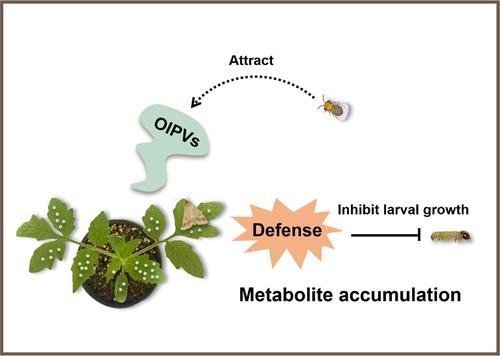当前位置:
X-MOL 学术
›
Pest Manag. Sci.
›
论文详情
Our official English website, www.x-mol.net, welcomes your
feedback! (Note: you will need to create a separate account there.)
The oviposition of cotton bollworms stimulates the defense against its eggs and larvae in tomato plants
Pest Management Science ( IF 3.8 ) Pub Date : 2024-11-08 , DOI: 10.1002/ps.8521 Jin‐Hua Shi, Rui Shao, Sara T Abdelkhalek, Shuo Zhang, Man‐Qun Wang
Pest Management Science ( IF 3.8 ) Pub Date : 2024-11-08 , DOI: 10.1002/ps.8521 Jin‐Hua Shi, Rui Shao, Sara T Abdelkhalek, Shuo Zhang, Man‐Qun Wang

|
BACKGROUNDHerbivorous insects sustain their populations by oviposition. To reduce the damage caused by herbivores, the host plant triggers a defensive response upon detection of egg deposition. However, the specific impact of the egg deposition time of the cotton bollworm Helicoverpa armigera (Lepidoptera: Noctuidae), on the tomato plant defense remains obscure.RESULTSThis study investigated the effects of tomato plant defenses on cotton bollworm eggs and larvae at different time intervals following egg deposition. The study revealed that tomato plant defense triggered by egg deposition did not directly affect the hatchability of the eggs. Nevertheless, it attracted Trichogramma chilonis 48 h after the egg deposition. Gas chromatography–mass spectrometry analysis of the oviposition‐induced plant volatiles (OIPVs) revealed a considerable increase in the amount of α ‐pinene released by tomato plants 48 h after egg deposition. The olfactory results from Y‐tube experiments showed that α ‐pinene exhibited a substantial attraction towards T. chilonis . In addition, it was found that the defense response induced by egg deposition for 24 and 48 h significantly inhibited the growth and development of the larvae. Metabolomics analysis revealed that the egg deposition of cotton bollworm altered the metabolite composition and caused significant modifications in the metabolic pathways of tomato plants.CONCLUSIONThese findings provide novel insights into pest management by using egg‐induced plant defenses to reduce egg hatching, and impede larval growth and development in herbivorous insects. © 2024 Society of Chemical Industry.
中文翻译:

棉铃虫的产卵刺激了番茄植株对其卵和幼虫的防御
背景食性昆虫通过产卵来维持其种群。为了减少食草动物造成的损害,寄主植物在检测到卵沉积后会触发防御反应。然而,棉铃虫 Helicoverpa armigera(鳞翅目:夜蛾科)的卵沉积时间对番茄植株防御的具体影响仍然不清楚。结果该研究调查了番茄植株防御对棉铃虫卵和幼虫在卵沉积后不同时间间隔的影响。研究表明,鸡蛋沉积触发的番茄植株防御不会直接影响鸡蛋的孵化率。尽管如此,它在卵沉积后 48 小时吸引了 Trichogramma chilonis。产卵诱导的植物挥发物 (OIPV) 的气相色谱-质谱分析显示,番茄植株在卵沉积后 48 小时释放的 α-蒎烯量显着增加。Y 管实验的嗅觉结果表明,α-蒎烯对 T. chilonis 表现出很大的吸引力。此外,发现卵沉积 24 和 48 h 诱导的防御反应显着抑制了幼虫的生长发育。代谢组学分析显示,棉铃虫的卵沉积改变了番茄植株的代谢物组成,并导致番茄植株的代谢途径发生显著改变。结论这些发现通过使用鸡蛋诱导的植物防御来减少鸡蛋孵化,并阻碍食草昆虫的幼虫生长和发育,为害虫管理提供了新的见解。© 2024 化工学会.
更新日期:2024-11-08
中文翻译:

棉铃虫的产卵刺激了番茄植株对其卵和幼虫的防御
背景食性昆虫通过产卵来维持其种群。为了减少食草动物造成的损害,寄主植物在检测到卵沉积后会触发防御反应。然而,棉铃虫 Helicoverpa armigera(鳞翅目:夜蛾科)的卵沉积时间对番茄植株防御的具体影响仍然不清楚。结果该研究调查了番茄植株防御对棉铃虫卵和幼虫在卵沉积后不同时间间隔的影响。研究表明,鸡蛋沉积触发的番茄植株防御不会直接影响鸡蛋的孵化率。尽管如此,它在卵沉积后 48 小时吸引了 Trichogramma chilonis。产卵诱导的植物挥发物 (OIPV) 的气相色谱-质谱分析显示,番茄植株在卵沉积后 48 小时释放的 α-蒎烯量显着增加。Y 管实验的嗅觉结果表明,α-蒎烯对 T. chilonis 表现出很大的吸引力。此外,发现卵沉积 24 和 48 h 诱导的防御反应显着抑制了幼虫的生长发育。代谢组学分析显示,棉铃虫的卵沉积改变了番茄植株的代谢物组成,并导致番茄植株的代谢途径发生显著改变。结论这些发现通过使用鸡蛋诱导的植物防御来减少鸡蛋孵化,并阻碍食草昆虫的幼虫生长和发育,为害虫管理提供了新的见解。© 2024 化工学会.


















































 京公网安备 11010802027423号
京公网安备 11010802027423号